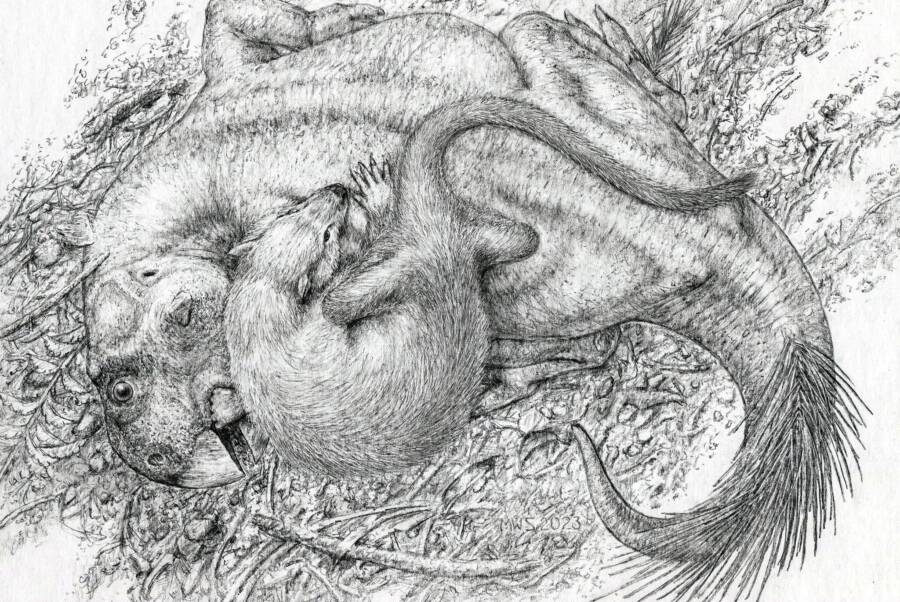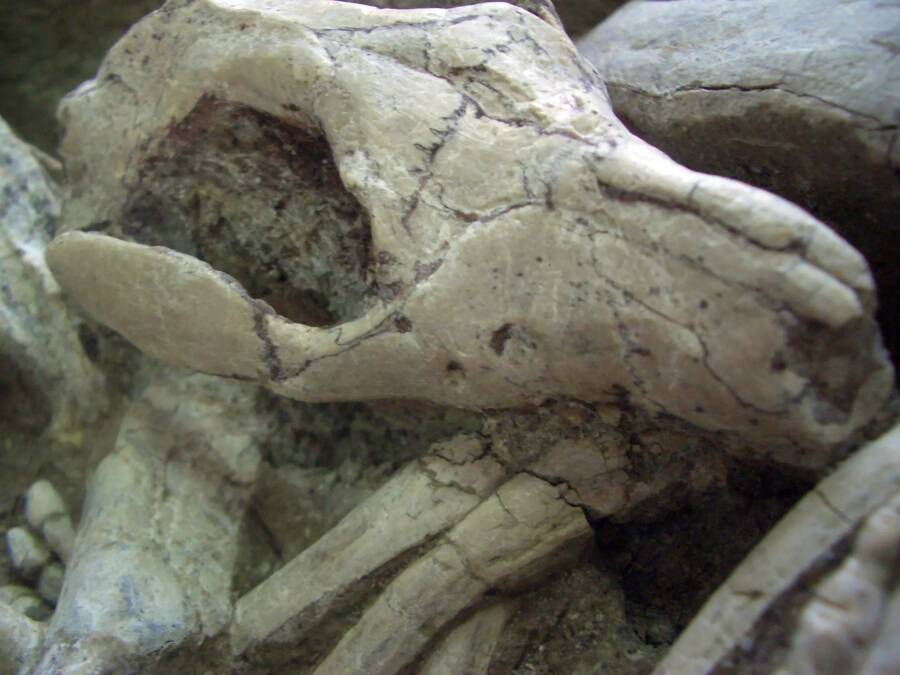The fossilized remains of a small badger-like creature called Repenomamus robustus attacking a dinosaur called Psittacosaurus lujiatunensis were apparently preserved by volcanic mud 125 million years ago.

Gang HanThe unique fossil has challenged long-held assumptions about the role mammals played in prehistoric times.
In 2012, farmers in China came across a fossil so incredible and well-preserved that it seemed fake. It contained, in stunning detail, the preserved remains of a small badger-like mammal and a larger dinosaur in the midst of a vicious fight that was preserved by volcanic mudflows.
“I’ve never seen a fossil like this before,” Jordan Mallon, a paleobiologist at the Canadian Museum of Nature and one of the authors of a new study on the find, exclaimed to the Associated Press.
As The New York Times reports, the extraordinary fossil shows a small badger-like creature called Repenomamus robustus grappling with a larger plant-eating horned dinosaur called Psittacosaurus lujiatunensis some 125 million years ago.
It’s unclear whether the Repenomamus was hunting the larger creature — Psittacosaurus remains have been discovered in the stomach of another Repenomamus before — or if the two were merely “scuffling.” But whatever the cause of the fight, it seems that the Repenomamus won.
“The dinosaur is lying prone on its front with its hindlimbs folded on either side of its body and its neck and tail curled to the left,” researchers explained in their study about the fossil. Meanwhile, “the mammal lies on top of the dinosaur’s left side and curves to the right.”
What’s more, the smaller mammal appeared to grip the dinosaur’s jaw with its left paw, while its left hind paw grips the dinosaur’s left shin. And the Repenomamus’ jaws are deep in the dinosaur’s ribs, suggesting that the mammal was able to land a fatal blow.

Michael SkrepnickA depiction of the final fight between Repenomamus robustus and Psittacosaurus lujiatunensis.
But the Repenomamus’ victory would have been short-lived. Just as the creature dug its jaws into the dinosaur’s side, volcanic mudflows poured over them and locked them in an eternal battle.
“[T]his mud flow sort of caught them off guard and preserved them for 125 million years,” Mallon explained to The New York Times.
The discovery has challenged some long-held assumptions about where mammals fit into the prehistoric world. Researchers have long believed that reptiles ruled the roost, while mammals were forced to eke out a living in their terrifying shadow.
“This turns the old story on its head,” University of Edinburgh paleontologist Steve Brusatte, who was not involved with the study, told the Associated Press. “We’re used to thinking of the Age of Dinosaurs as a time when dinosaurs ruled the world, and the tiny mammals cowered in the shadows.”
In a press release, Mallon acknowledged that the fossil was “among the first evidence to show actual predatory behavior by a mammal on a dinosaur” but also pointed out that modern-day animals engage in similar behavior.
“There are examples today of small carnivorous mammals taking down much, much larger prey,” he told The New York Times, citing how wolverines take down much larger animals like caribou. “We think Repenomamus was probably similarly a small, feisty predator that was willing to take down prey that was much larger than itself if it had to.”
In fact, the fossil is so well-preserved and presents such a clear picture of the role that mammals might have once played that some believe that it was faked. Mallon and his study co-authors dedicated a section of their study to these concerns, but he’s convinced that the fossil is genuine.

Gang HanRepenomamus robustus biting into the dinosaur’s side.
He and the other researchers noted that Repenomamus’ left lower jaw “was indeed plunging into the rock and was indeed biting the ribs of the dinosaur” and did not appear to be staged.
“We feel fairly satisfied that this is a genuine fossil and it is not a fake,” Mallon told The New York Times. He added that if the incredible fossil is a fake then it’s “the best I’ve ever seen.”
After reading about the fossil that preserved a final fight between a mammal and a dinosaur from 125 million years ago, see how scientists were able to see dinosaur embryos inside 200-million-year-old fossilized dinosaur eggs. Or, learn about the hadrosaur fossil found in a rock face in Canada, which might be so well preserved that it still has intact skin.





